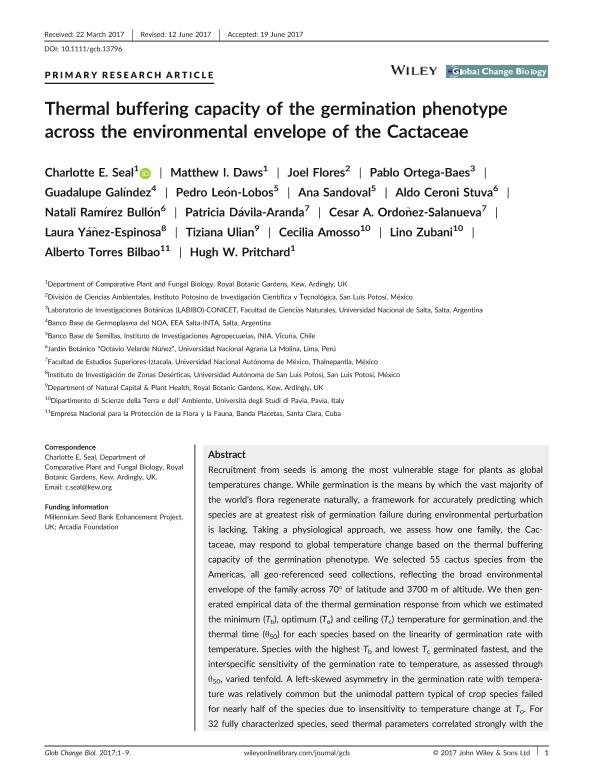Mostrar el registro sencillo del ítem
dc.contributor.author
Seal, Charlotte E.
dc.contributor.author
Daws, Matthew I.
dc.contributor.author
Flores, Joel
dc.contributor.author
Ortega Baes, Francisco Pablo

dc.contributor.author
Galindez, Guadalupe

dc.contributor.author
León Lobos, Pedro
dc.contributor.author
Sandoval, Ana
dc.contributor.author
Ceroni Stuva, Aldo
dc.contributor.author
Ramírez Bullón, Natali
dc.contributor.author
Dávila-Aranda, Patricia
dc.contributor.author
Ordoñez Salanueva, Cesar A.
dc.contributor.author
Yáñez Espinosa, Laura
dc.contributor.author
Ulian, Tiziana
dc.contributor.author
Amosso, Cecilia
dc.contributor.author
Zubani, Lino
dc.contributor.author
Torres Bilbao, Alberto
dc.contributor.author
Pritchard, Hugh W.
dc.date.available
2018-12-07T20:29:24Z
dc.date.issued
2017-12
dc.identifier.citation
Seal, Charlotte E.; Daws, Matthew I.; Flores, Joel; Ortega Baes, Francisco Pablo; Galindez, Guadalupe; et al.; Thermal buffering capacity of the germination phenotype across the environmental envelope of the Cactaceae; Wiley Blackwell Publishing, Inc; Global Change Biology; 23; 12; 12-2017; 5309-5317
dc.identifier.issn
1354-1013
dc.identifier.uri
http://hdl.handle.net/11336/66118
dc.description.abstract
Recruitment from seeds is among the most vulnerable stage for plants as global temperatures change. While germination is the means by which the vast majority of the world's flora regenerate naturally, a framework for accurately predicting which species are at greatest risk of germination failure during environmental perturbation is lacking. Taking a physiological approach, we assess how one family, the Cactaceae, may respond to global temperature change based on the thermal buffering capacity of the germination phenotype. We selected 55 cactus species from the Americas, all geo-referenced seed collections, reflecting the broad environmental envelope of the family across 70° of latitude and 3700 m of altitude. We then generated empirical data of the thermal germination response from which we estimated the minimum (Tb), optimum (To) and ceiling (Tc) temperature for germination and the thermal time (θ50) for each species based on the linearity of germination rate with temperature. Species with the highest Tb and lowest Tc germinated fastest, and the interspecific sensitivity of the germination rate to temperature, as assessed through θ50, varied tenfold. A left-skewed asymmetry in the germination rate with temperature was relatively common but the unimodal pattern typical of crop species failed for nearly half of the species due to insensitivity to temperature change at To. For 32 fully characterized species, seed thermal parameters correlated strongly with the mean temperature of the wettest quarter of the seed collection sites. By projecting the mean temperature of the wettest quarter under two climate change scenarios, we predict under the least conservative scenario (+3.7°C) that 25% of cactus species will have reduced germination performance, whilst the remainder will have an efficiency gain, by the end of the 21st century.
dc.format
application/pdf
dc.language.iso
eng
dc.publisher
Wiley Blackwell Publishing, Inc

dc.rights
info:eu-repo/semantics/openAccess
dc.rights.uri
https://creativecommons.org/licenses/by-nc-sa/2.5/ar/
dc.subject
Cactaceae
dc.subject
Comparative Physiology
dc.subject
Germination Phenotype
dc.subject
Interspecific Variation
dc.subject
Phenotypic Plasticity
dc.subject
Predictive Model
dc.subject
Thermal Resilience
dc.subject
Thermal Time
dc.subject
Threatened Species
dc.subject.classification
Otras Ciencias Biológicas

dc.subject.classification
Ciencias Biológicas

dc.subject.classification
CIENCIAS NATURALES Y EXACTAS

dc.title
Thermal buffering capacity of the germination phenotype across the environmental envelope of the Cactaceae
dc.type
info:eu-repo/semantics/article
dc.type
info:ar-repo/semantics/artículo
dc.type
info:eu-repo/semantics/publishedVersion
dc.date.updated
2018-12-05T14:47:24Z
dc.journal.volume
23
dc.journal.number
12
dc.journal.pagination
5309-5317
dc.journal.pais
Reino Unido

dc.journal.ciudad
Londres
dc.description.fil
Fil: Seal, Charlotte E.. Royal Botanic Gardens; Reino Unido
dc.description.fil
Fil: Daws, Matthew I.. Royal Botanic Gardens; Reino Unido
dc.description.fil
Fil: Flores, Joel. Instituto Potosino de Investigación Científica y Tecnológica; México
dc.description.fil
Fil: Ortega Baes, Francisco Pablo. Consejo Nacional de Investigaciones Científicas y Técnicas. Centro Científico Tecnológico Conicet - Salta; Argentina. Universidad Nacional de Salta. Facultad de Ciencias Naturales. Escuela de Agronomía. Laboratorio de Investigaciones Botánicas; Argentina
dc.description.fil
Fil: Galindez, Guadalupe. Consejo Nacional de Investigaciones Científicas y Técnicas. Centro Científico Tecnológico Conicet - Salta; Argentina. Instituto Nacional de Tecnología Agropecuaria. Centro Regional Salta. Estación Experimental Agropecuaria Salta; Argentina
dc.description.fil
Fil: León Lobos, Pedro. Instituto de Investigaciones Agropecuaria; Chile
dc.description.fil
Fil: Sandoval, Ana. Instituto de Investigaciones Agropecuaria; Chile
dc.description.fil
Fil: Ceroni Stuva, Aldo. Universidad Nacional Agraria La Molina; Perú
dc.description.fil
Fil: Ramírez Bullón, Natali. Universidad Nacional Agraria La Molina; Perú
dc.description.fil
Fil: Dávila-Aranda, Patricia. Universidad Nacional Autónoma de México; México
dc.description.fil
Fil: Ordoñez Salanueva, Cesar A.. Universidad Nacional Autónoma de México; México
dc.description.fil
Fil: Yáñez Espinosa, Laura. Universidad Autónoma de San Luis Potosí; México
dc.description.fil
Fil: Ulian, Tiziana. Royal Botanic Gardens; Reino Unido
dc.description.fil
Fil: Amosso, Cecilia. Università di Padova; Italia
dc.description.fil
Fil: Zubani, Lino. Università di Padova; Italia
dc.description.fil
Fil: Torres Bilbao, Alberto. Empresa Nacional para la Protección de la Flora y la Fauna; Cuba
dc.description.fil
Fil: Pritchard, Hugh W.. Royal Botanic Gardens; Reino Unido
dc.journal.title
Global Change Biology

dc.relation.alternativeid
info:eu-repo/semantics/altIdentifier/doi/https://dx.doi.org/10.1111/gcb.13796
dc.relation.alternativeid
info:eu-repo/semantics/altIdentifier/url/https://onlinelibrary.wiley.com/doi/full/10.1111/gcb.13796
Archivos asociados
